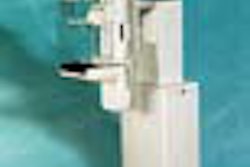The Food and Drug Administration's decision to clear GE's Senographe 2000D digital mammography system for use in the U.S. has been heralded as a groundbreaking development, offering the promise of substantial improvements in patient care. It is uncertain how quickly healthcare institutions will put digital mammography to use, however.
The benefits of digital mammography are indeed alluring. Digital systems provide better contrast resolution and dynamic range than film, and it is easier for digital images to be manipulated and transmitted to other locations. Digital systems are also better than analog systems for imaging women with dense breasts, and preliminary research data have found a reduction in false-positive cases using digital imaging. Adjunctive technologies such as computer-aided diagnosis -- GE is partnering with CAD developer R2 Technology of Los Altos, CA -- could also lead to diagnostic improvements.
But digital mammography faces several barriers to widespread implementation, perhaps the most prominent of which is its high cost. At approximately $500,000, Senographe 2000D is roughly five times more expensive than traditional film-screen systems.
Presently, digital mammography units also confer lower spatial resolution than film, although the technology's superior contrast resolution more than makes up for this deficiency, according to Dr. Edward Sickles, a professor of radiology at the University of California, San Francisco. In addition, image quality will undoubtedly continue to improve as the modality matures.
Another potential issue that could affect digital mammography's near-term success is the fact that the FDA has approved the GE system for use only in hard-copy applications. While enthusiastic that the FDA has finally granted clearance for a full-field digital mammography system, mammography experts largely believe that hard-copy digital mammography does not provide radiologists with the key benefits of the technology.
"Hard copy is very cost-inefficient and will not be the ultimate way in which digital mammography is applied," Sickles said.
GE plans to pursue soft-copy applications for Senographe 2000D, and is already working with the agency on a regulatory filing, according to GE spokesperson Charlie Young. Young declined to comment on an estimated date for soft-copy clearance.
Changes in store
Of course, shifting to a soft-copy environment for mammography will require process changes for radiologists, who are used to reading mammography from film. Perhaps the most serious deterrent to digital mammography, however, is simple economics. With mammography generating under $100 in reimbursement per study, healthcare institutions will be hard-pressed initially to cost-justify a system four to five times as expensive as a film-screen unit, according to Dr. Etta Pisano, chief of breast imaging at the University of North Carolina at Chapel Hill.
"Screening mammography does not pay well," she said. "Right now, digital mammography is a tough sell, but we do expect system costs to come down."
If future research studies find that digital mammography is more cost-effective than traditional film-screen breast imaging, it could lead to higher reimbursement levels for digital mammography studies. The National Cancer Institute is sponsoring the American College of Radiology Imaging Network (ACRIN) clinical trials group, which is readying a screening trial that compares digital to film-screen mammography. One of the goals of that trial will be to compare the cost-effectiveness of the two modalities. The committee hopes to launch the multisite trial this summer, Pisano said.
With GE's approval for Senographe 2000D, other vendors are sure to follow with clearances for their systems. In addition, GE's clearance will likely encourage firms to invest more resources in improving their technology, UCSF's Sickles said. GE undoubtedly will try to take advantage of being the first to market with its system, which has been cleared for both screening and diagnostic applications.
To help hospitals justify the purchase of Senographe 2000D, GE will highlight the experiences of its users outside the U.S., who have reported substantially improved image quality, reduction in patient call-backs, and productivity gains due to higher patient throughput. At Charite Hospital in Berlin, three to four times as many patients are being imaged per day with the digital system than with a comparable analog system, GE's Young said.
U.S. shipments of Senographe 2000D will begin almost immediately, Young said. In 1999, the system was approved for sale in Europe, Canada, Latin America and much of Asia. Nearly 50 systems are already in use, according to the Waukesha, WI-based vendor.
By Erik L. Ridley
AuntMinnie.com staff writer
February 7, 2000

















